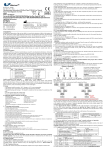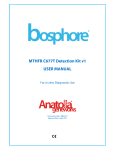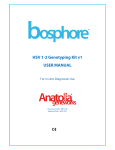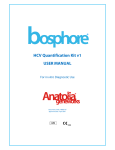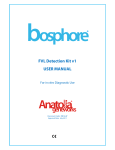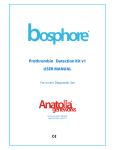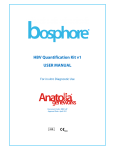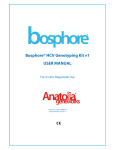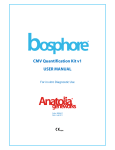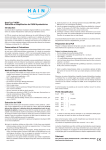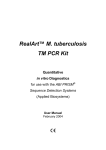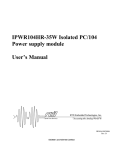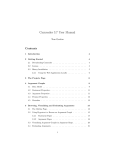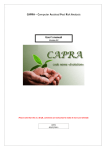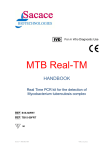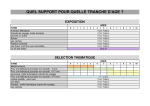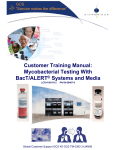Download MTBC Detection Kit v1 USER MANUAL
Transcript
® MTBC Detection Kit v1 USER MANUAL For in vitro Diagnostic Use ® Document Code: MB05v2f Approval Date: July 2011 IVD Contents Page 1. Product Description 1 2. Content 1 3. Storage 1 4. Required Materials and Devices 1 5. Important Notes and Safety Instructions 2 6. Product Use Limitations 2 7. Pathogen 2 8. Method 3 9. Procedure 4 9.1. Sample Preparation, Storage and Transport 4 9.2. Interfering Substances 4 9.3. DNA Isolation 4 9.4. Kit Components 4 9.4.1. PCR Mix 4 9.4.2. Detection Mix 1 4 9.4.3. Detection Mix 2 4 9.4.4. Internal Control 4 9.4.5. Positive Control 5 9.5. Preparing the PCR 5 9.6. Programming the Montania® 483 Real-Time PCR Instrument 5 10. Analysis 7 11. Troubleshooting 9 12. Specifications 10 12.1. Sensitivity 10 12.2. Cross-Reactivity 10 12.3. Reproducibility and Precision 10 13. References 11 14. Symbols 11 15. Contact Information 11 Code: MB05v2f Date: July 2011 ii 1. PRODUCT DESCRIPTION Bosphore® MTBC Detection Kit v1 detects MTBC DNA in human biological samples, encompassing all the complex MTBC genotypes ( M. tuberculosis, M. bovis, M. bovis BCG, M. africanum, M. canetti, M. caprae, M. microti and M. Pinnipedi). The analytic sensitivity is 128 copies/ml. A region within the 16S ribosomal RNA gene is amplified and fluorescence detection is accomplished using the FAM filter. An internal control has been integrated into the kit in order to check PCR inhibition. The amplification data of the internal control is detected with the Cy5 filter. The internal control is added during PCR step. 2. CONTENT Bosphore® MTBC Detection Kit v1 is composed of Real-Time PCR reagents, an internal control and a positive control. Component 1 2 3 4 5 6 REAGENT dH2O PCR Mix Detection Mix1 Detection Mix2 Internal Control Positive Control 1 100 Tests (1000 µl) (2240 µl) (176 µl) (132 µl) (23µl) (160 µl) 50 Tests (1000 µl) (1120 µl) (88 µl) (66 µl) (15 µl) (80 µl) 25 Tests (500 µl) (560 µl) (44 µl) (33µl) (15 µl) (40 µl) 3. STORAGE Bosphore® MTBC Detection Kit v1 PCR reagents should be stored at -20°C. Repeated thawing and freezing (>3x) should be avoided since it may reduce sensitivity. If the components are to be used in small amounts, they should be frozen in aliquots. While preparing the PCR; the components should not be exposed to room temperature for more than 10 min. and the detection mix components should not be exposed to light more than 1-2 min. We recommend preparing the PCR on a cooling block and keeping the detection mixes within a closed container. The components maintain their stability until the expiry dates on the labels, if they are stored at advised conditions. 4. REQUIRED MATERIALS AND DEVICES • Montania® 483 Real-Time PCR Instrument (Anatolia Geneworks), or another Real-Time PCR system with FAM and Cy5 filters (iCycler, iQ5, CFX–BioRad, LightCycler 1.5, 2.0, 480-Roche, 7500 Real-Time PCR System-ABI, Stratagene Mx3005P, Mx3000P-Agilent, LineGeneK, LineGene 9600-Bioer, Rotorgene 2000, 3000, 6000, Q-Qiagen) • 0.2 ml Thin-Wall PCR tubes or strips • Magnesia® 16 Nucleic Acid Extraction System / Magnesia® Bacterial DNA Extraction Kit (Anatolia Geneworks) or other high quality DNA extraction kits and systems • Deep freezer (-20°C) • Desktop centrifuge with rotor for 2 ml. microcentrifuge tubes • Calibrated adjustable micropipettes • DNAse, RNAse, pyrogen free micropipette tips with filters • DNAse, RNAse, pyrogen free 1.5 or 2 ml. microcentrifuge tubes • Disposable laboratory gloves Code: MB05v2f Date: July 2011 1 5. IMPORTANT NOTES AND SAFETY INSTRUCTIONS Important!: • The product should be delivered on dry ice. Check for presence of dry ice upon arrival. • Check for the expiry dates on the box and tube labels, upon arrival. Do not use expired products or components. • Calibrated or verified micropipettes, DNAse, RNAse, pyrogen free micropipette tips with filters, and DNAse, RNAse, pyrogen free microcentrifuge tubes should be used. • Before starting a test procedure, all components should be thoroughly thawed. After thawing, all components should be centrifuged briefly (spin-down for 3-5 seconds), and mixed well to ensure homogeneity prior to use. • The kit components should be kept on ice or a cooling block until the reaction is prepared, and they should be quickly returned to -20ºC. • PCR and nucleic acid isolation must be performed in different compartments. Samples should be stored separately to avoid contact with the kit components. • Pathogen information should be reviewed to be aware of the health related risks. • Clinical samples should be handled with extreme caution: Physical contact with pathogens should be avoided by; wearing lab coats and gloves, no allowance for eating or drinking within the workspace, prevention of unauthorized individuals’ access to the working area. • All the pathogenic wastes produced during the nucleic acid isolation step; including the biological samples and material contacted with them, should be discarded into medical waste and disposed safely. 6. PRODUCT USE LIMITATIONS • All the components may exclusively be used for in vitro diagnostics. • This product should be used in accordance with this user manual. • This product is to be used by personnel specially trained to perform in vitro diagnostic procedures. 7. PATHOGEN Causative Agents MTBC (Mycobacterium Tuberculosis Complex) contains seven closely related bacteria species with distinct host tropisms including M. tuberculosis, M. bovis, M. bovis BCG, M. africanum, M. canetti, M. caprae, M. microti and M. Pinnipedi. The most common member of the complex is the M. Tuberculosis. The human pathogens M. africanum and M. canettii and species adapted to animals M. bovis (bovine), M. caprae (goats), M. pinnipedii (seals), and M. microti (rodents) are the other members of the complex. Members of the MTBC are estimated as genetically monomorphic with a high level of genomic sequence similarity (>99.95%), limited horizontal gene transfer, and a clonal population structure. It is accepted as the genetic diversity among MTBC strains has not any clinical significance because of this apparent homogeneity. They cause tuberculosis in humans by localizing in the lungs.[1] Code: MB05v2f Date: July 2011 2 Epidemiology Tuberculosis is the most common second infection worldwide causing the death of young and older people. One-third of the world population is infected with tuberculosis. Each year 9 million people worldwide have been infected with tuberculosis and nearly 2 million of this has resulted in death. In Turkey between 10 million and 20 million people are infected with tuberculosis and carry infectious agent of tuberculosis (mycobacterium tuberculosis). The prevalence of TB is approximately 27 in one hundred thousand. [2], [3] Modes of Transmission Even though it can affect all organs of the body, the main entry of the infection is respiratory system through lung. It is transmitted through air droplets which are generated when TB infected persons cough, sneeze, speak, etc. Also being in close contact with a person that has active TB disease with TB germs present in the sputum and consumption of unpasteurized infected cow's milk that has Mycobacterium bovis are the other causes of the human tuberculosis. [4] 8. METHOD Bosphore® MTBC Detection Kit v1 is based on the Real-Time PCR method. Polymerase chain reaction is a technique that is used for amplification of a DNA region. The reaction occurs by the repeating cycles of heating and cooling. The main components of PCR are primers, dNTPs, Taq polymerase enzyme, buffer solution and template. As a brief explanation, primers are small synthetic DNA those anneal to the specific regions of the template in order to start the synthesis. dNTPs are the building blocks of the amplified products. Taq polymerase amplifies the DNA template. Buffer solution provides the pH adjustment required for the reaction and template, as referred, is the target region for synthesis. In Real Time PCR technique, in contrast to conventional PCR, PCR product can be monitored during the reaction. Therefore Real-Time PCR obviates the need for further analysis methods like gel electrophoresis, whereby minimizing the risk of contamination. Dual labeled probes employed in the reaction in addition to the conventional PCR reagents, enable detection of the amplified target with increased sensitivity. The assay utilizes the 5’ exonuclease activity of Taq Polymerase to cleave a dual-labeled fluorescent hybridization probe during the extension phase of PCR. The probe is labeled at the 5’ end with a fluorescent ‘reporter’ molecule, and at the 3’end with another fluorescent molecule that acts as a ‘quencher’ for the ‘reporter’. When the two fluorophores are in close proximity, and the reporter is excited by light, no reporter fluorescence can be detected. During the elongation step of PCR, Taq Polymerase encounters and cleaves the probe bound to the template. As the reporter is freed from the suppressing effect of the quencher, fluorescence signal can be detected. The fluorescence generated by the reporter increases as the PCR product is accumulated; the point at which the signal rises above background level and becomes distinguishable, is called the threshold cycle (CT). There is a linear relationship between the log of the starting amount of a template and its threshold cycle. Bosphore MTBC Detection Kit v1 employs multiplex PCR, and an internal control is incorporated into the system in order to check for possible PCR inhibition. MTBC DNA and an internal control are co-amplified in a single reaction, using sequence-specific primers. The fluorescent signal generated by the MTBC amplification is detected by a probe labeled at the 3’ end with FAM, through the FAM channel. The fluorescent signal generated by the internal control amplification, is detected by a second probe (labeled at the 5’ end with a different reporter molecule, Cy5) through the Cy5 channel. Code: MB05v2f Date: July 2011 3 9. PROCEDURE 9.1. Sample Preparation, Storage and Transport Human respiratory samples such as bronchoalveolar lavage (BAL), sputum, bronchial mucosa should be collected. To isolate bacterial DNA from the clinical specimen, great care should be taken to avoid exogenous contamination with mycobacterium. All steps of DNA extraction must be performed under a biological safety cabinet. In order to ensure safety, samples might be processed in a decontamination procedure, if desired. On the other hand, decontamination procedures might reduce the sensitivity of the assay. Specimen should be stored at 4°C for short-term (24 hours) if it is to be processed in a day or frozen at -20°C for longer periods of time. Sensitivity of the PCR might be reduced because of repeated cycles of freeze-thaw. DNase/RNAse free polypropylene tubes must be used for storage. The samples should be transported in containers with capacity to resist pressure. Transportation should be done according to local and national regulations for pathogen material transport. 9.2. Interfering Substances To avoid possible influences on PCR: • Samples which have been collected in waxed containers or in propylene glycol test tubes • Food particles or mouthwash • Decontamination reagents such as isoniazid might reduce PCR sensitivity. must not be used. 9.3. DNA Isolation We recommend that the Magnesia® 16 Nucleic Acid Extraction System / Magnesia® Bacterial DNA Extraction Kit (Anatolia Geneworks) isolation system or an alternative high quality DNA extraction system is used with Bosphore® MTBC Detection Kit v1. The DNA isolation should be performed according to the manufacturers’ instructions. The starting volume is 200 µl, the elution volume is 100 µl. 9.4. Kit Components 9.4.1. PCR Mix HotStarTaq DNA Polymerase: HotStarTaq DNA Polymerase is a modified form of a recombinant 94 kDa DNA polymerase, originally isolated from Thermus aquaticus, cloned into E.Coli. The enzyme is provided in an inactive form. It is activated by a 15-minute 95 ºC incubation step. This prevents the formation of misprimed products and primer-dimers during reaction setup and the first denaturation step, leading to high PCR specificity and accurate qualitative analysis. QuantiTect Probe PCR Buffer: contains Tris-Cl, KCl, (NH4)2SO4, 8 mM MgCl2, pH 8.7 (20ºC ). dNTP Mix: Contains ultrapure quality dATP, dGTP, dCTP ve dTTP/dUTP. 9.4.2. Detection Mix 1 Detection Mix 1 contains MTBC-specific forward and reverse primers and a dual-labeled probe. 9.4.3. Detection Mix 2 Detection Mix 2 contains internal control-specific forward and reverse primers and a dual-labeled probe. 9.4.4. Internal Control An internal control is included in the kit to control PCR inhibition. The internal control is a synthetic DNA molecule derived from human genome. It is added directly into the PCR master mix to control the PCR inhibition exclusively. For this purpose, 0.2 µl of internal control should be added for each reaction into the master mix. Lack of Code: MB05v2f Date: July 2011 4 internal control amplification in the FAM negative samples, may indicate a problem in PCR or PCR inhibition. In this case, PCR should be repeated. In samples that contain a high bacterial load, internal control can be suppressed and no increase of the signal is detected. Please use the table below for the interpretation of internal control data: MTBC (FAM) + + - 9.4.5. Internal Control (Cy5) + + - Interpretation Sample positive Sample negative Sample positive Repeat the test! Positive Control The positive control contains MTBC DNA. It can be included in the PCR to test the efficiency of the PCR exclusively. The threshold cycle for the positive control is given in the acceptance criteria table (Section 10. Analysis). Threshold cycles higher than the acceptance criteria may indicate an efficiency loss in the reaction. 9.5. Preparing the PCR Positive control should be added into the PCR reaction together with the samples and the negative control (PCR-grade water) in order to deduce the positivity/negativity of the samples. Make sure that all the kit components are thawed before use. Refer to the table below for preparing the PCR. It is for only one reaction, multiply these values with the sample number to find the values required for the master mix. While preparing master mixes for more than 5 samples, an extra 10% should be added to the total sample number. PCR Mix Detection Mix 1 Detection Mix 2 Internal Control 20 µl 1.6 µl 1.2 µl 0.2 µl Sample DNA Negative/Positive Control 18 µl Total Volume 41.0 µl Pipette 23 µl of the master mix into the PCR tubes or strips, and add 18 µl of DNA (sample/positive or negative control). Close the tube cap. Make sure that the solution in each tube is at the bottom of the tube. Centrifuge if necessary. 9.6. Programming the Montania® 483 Real-Time PCR Instrument The thermal protocol for Bosphore® MTBC Detection Kit v1 is composed of an initial denaturation for activation the HotStarTaq DNA Polymerase, a two-step amplification cycle and a terminal hold. The real-time data is collected at the second step of the amplification cycle. Initial denaturation Denaturation Annealing and Synthesis (Data Collection) Hold 95°C 97°C 53°C 14:30 min. 00:30 min. 01:30 min. 22°C 05:00 50 cycles Montania® 483 Real-Time PCR Instrument is installed and calibrated as it is delivered to the end user. In order to establish an appropriate link between the system components, first the thermal cycler and the optical module, and then the PC and the software should be started. Before starting a Real-Time PCR reaction using the Bosphore® Kits, the following steps should be completed: • Choose the filter pairs to be used (FAM and Cy5). Code: MB05v2f Date: July 2011 5 • Identify unknown samples, positive and negative controls. • Select the correct thermal protocol. These steps are described below: From the main menu of the Montania® 483 Real-Time PCR Instrument, “File” and then “New” is selected. “Create a new Experiment” is selected. In the “Select Channel” window channels 1 (FAM) and 3 (Cy5) are selected (Fig. 1). Samples positive and negative controls are identified in the “Module Edit” menu (Fig. 2). To select the thermal protocol “Gene Amplification” menu is used. The “Open” button in the “Experiment Program” is clicked and the appropriate thermal protocol is selected. (Fig. 3a). The thermal cycles of the selected protocol is displayed. The experiment starts by clicking the “Start” button (Fig. 3b). Fig. 1: Filter Selection in Montania® 483 Fig. 2: Sample Location and Identification Code: MB05v2f Date: July 2011 6 Fig. 3a: Selecting the Thermal Protocol Fig. 3b: Starting the Experiment 10. ANALYSIS By the end of the thermal protocol, the Montania® 483 Real-Time PCR Instrument software automatically calculates the baseline cycles and the threshold. Example of an amplification curve is given in Fig. 4. Code: MB05v2f Date: July 2011 7 Fig. 4: Amplification Curve of a Bosphore® MTBC v1 test Analysis of the results should be performed by trained personnel who have received the required training for analysing Real-Time PCR data. We recommend that the test results must be evaluated by an expert clinician, taking the patient’s clinical findings and the results of other tests into consideration. All analysis is done automatically in routine use. However, when the trained personnel, who have received the required training from manufacturer, consider it as necessary, the system allows pulling down the threshold as much as possible in order to detect low positive samples. In this case, attention should be paid to keep the threshold line above the background and to keep the correlation coefficient at the maximum possible value (and within its acceptance criteria.) Positive control of Bosphore® MTBC v.1 is essential for accurate result analysis. The cycle threshold acceptance criteria for the positive control is 33±4 . Test results should not be reported unless the assay results meet the criteria stated above. Please contact the manufacturer if impairment in the product’s performance is observed (See the last page for contact information). The qualitative results of the test are displayed on the “Report Mode” screen. The samples that cross the threshold in Channel 1 (FAM) are displayed as positive whereas samples that do not cut the threshold are displayed as “Negative” or “No Ct”. These samples are regarded as negative or having a bacterial load below the detection limit of the assay. For these undetectable samples, the Cy5 data of the internal control should also be checked to avoid false negative results (Fig. 6). Code: MB05v2f Date: July 2011 8 Fig. 6: A Report Mode Screen Showing the Results The following table shows the possible results and their interpretation: Signal detected in FAM filter pair The sample contains MTBC DNA, the result is positive No signal in signal in Cy5 The MTBC DNA in the sample is not detectable FAM, No signal in FAM and Cy5 The diagnosis inconclusive is No need to check the internal control since the sample is positive (high positive samples may suppress the signal from the internal control) Signal from Cy5 filter pair rules out the possibility of PCR inhibition No signal in Cy5 points out to PCR inhibition or to a problem in DNA isolation (See 11.Troubleshooting) 11. TROUBLESHOOTING Please contact the manufacturer in case of a problem during a run. Late or no signal from the FAM filter from the positive control Wrong thermal Make sure that the correct thermal protocol is chosen. protocol is chosen Deterioration of the Don’t use expired positive control or kit components. Follow positive control the instructions for the storage of kit components (Section 3. Storage). No signal from the internal control Deterioration of the internal control or detection mix 2 PCR inhibition DNA lost during isolation Signal from FAM Filter in the Negative Control Contamination The Threshold is Above Low Signals The threshold should be manually adjusted Follow the instructions for the storage of kit components (See Section 3. Storage). Make sure that you use the recommended DNA isolation method (See 9.3 DNA isolation). Make sure that you use the recommended DNA isolation method (See 9.3 DNA isolation). Use filter-tips. Repeat PCR with new kit components. Using the mouse pull the threshold down until it cuts the low signals. Avoid the background and the signal from negative control. Uneven Traces Baseline cycles should be readjusted Code: MB05v2f Date: July 2011 Assign new baseline cycles manually and recalculate threshold cycles. 9 12. SPECIFICATIONS 12.1. Sensitivity Analytical sensitivity may be expressed as the limit of detection: i.e. the smallest amount of the target marker that can be precisely detected. The detection limit of an individual analytical procedure is the lowest amount of nucleic acid in a sample which can be detected but not necessarily quantitated as an exact value. The analytical sensitivity or detection limit for NAT assays is expressed by the 95% positive cut-off value. The analytical detection limit for Bosphore® MTBC v1 was found to be 1.28x101 copies/ml (p=0.05). The sensitivity was determined using a dilution series of a quantitated DNA Control. The dilutions were tested in different runs in replicates. The results were analyzed by probit method. 12.2 Cross-Reactivity To eliminate potential cross-reactivity, both assay design evidence and experimental studies were employed. Primer and probe sequences were checked for possible homology to other known pathogen sequences by sequence comparison analysis using database alignment. Samples of Chlamydia, Toxoplasma, CMV, EBV, Parvovirus B19, BKV with known high positivity were tested, and found negative. 12.3 Reproducibility Reproducibility data (on CT value basis) were obtained by the analysis of positive control of the Bosphore® MTBC Detection Kit v1. Test was performed in at least 4 replicates by 3 different operators, on multiple days, using 3 different lots. The resulting data is given in Table 1: Table 1: Reproducibility Data. MTBC (104 copies/ml) Standard deviation Variance Coefficient of variation [%] Intra-assay Variability N=4 0.043 0,0018 0,13 Inter-lot Variability N=3 0,070 0,0052 0,21 0.0002 0.05 0,0018 0,13 Inter-operator Variability N=3 Total Inter-assay Variability N=5 Code: MB05v2f Date: July 2011 0,017 0.043 10 13. REFERENCES 1. K. E. Nelson, C. Williams, and N. Graham., Infectious Disease Epidemiology: Theory and Practice, July 15, 2000, p :653-655 2. Anonymous, Tuberculosis Fact Sheet, 2009 Update, World Health Organization. 3. Thierry Zozio, Caroline Allix, Selami Gunal, Genotyping of Mycobacterium tuberculosis clinical isolates in two cities of Turkey: Description of a new family of genotypes that is phylogeographically specific for Asia Minor, BMC Microbiol. 2005; 5: 44 4. Barry R. Bloom ,William N. Rom ,Stuart M. Garay , Tuberculosis: Pathogenesis, Protection, and Control ,Oct 1, 1994, p:47-49 14. SYMBOLS Use by Lot/Batch REF Catalog number Temperature limitation Caution, consult accompanying documents Manufacturer IVD In Vitro Diagnostic Medical Device 15. CONTACT INFORMATION Anatolia Geneworks Egitim Mh. Kasap Ismail Sk. No:10/23 Kadikoy 34722 ISTANBUL-TURKEY Phone: +90 216 330 04 55 Fax: +90 216 330 00 42 E-mail: [email protected] www.anatoliageneworks.com Registered Trademarks: Anatolia Geneworks® Montania®, Magnesia® and Bosphore® are registered trademarks of Anatolia Tani ve Biyoteknoloji A.S. Code: MB05v2f Date: July 2011 11













